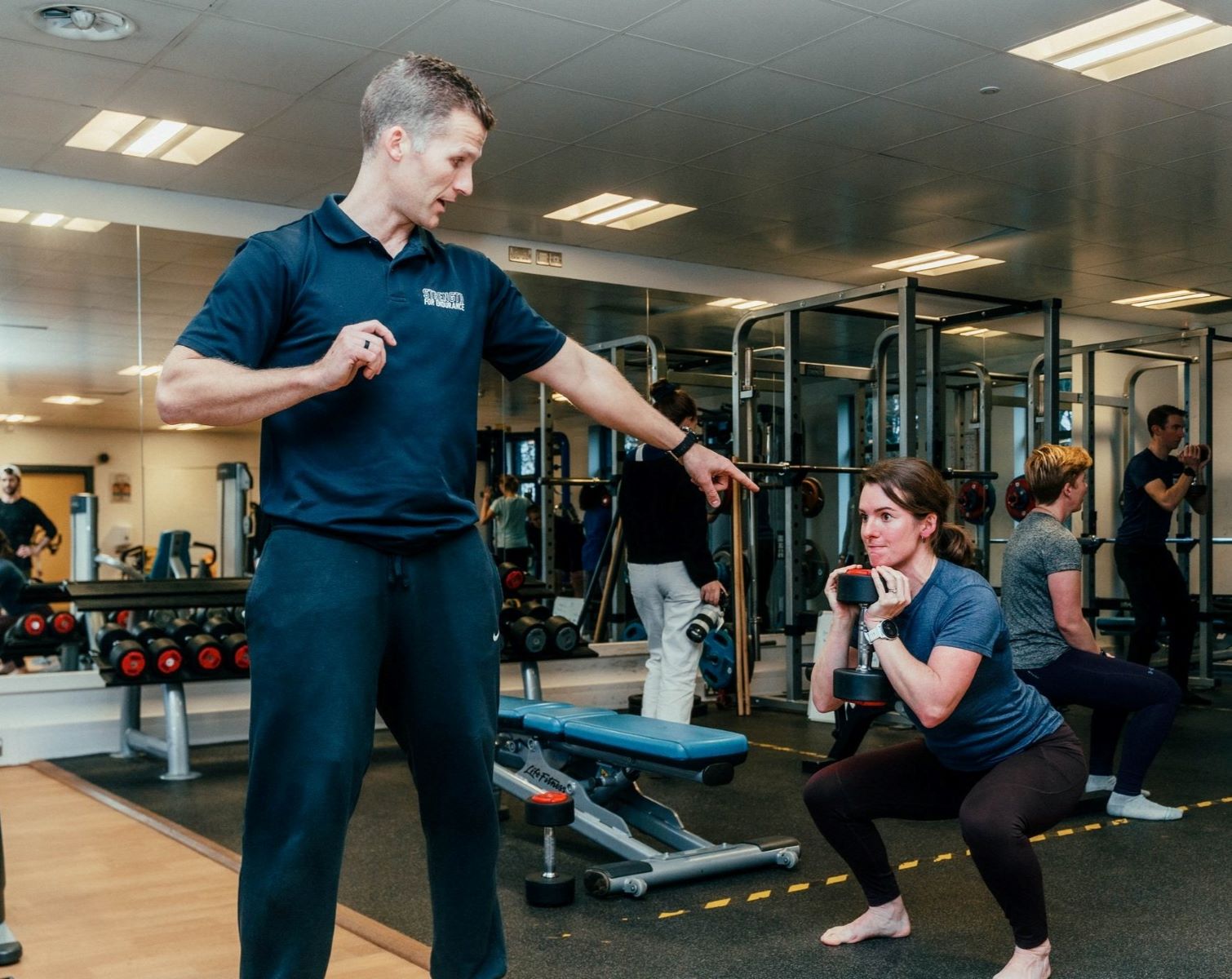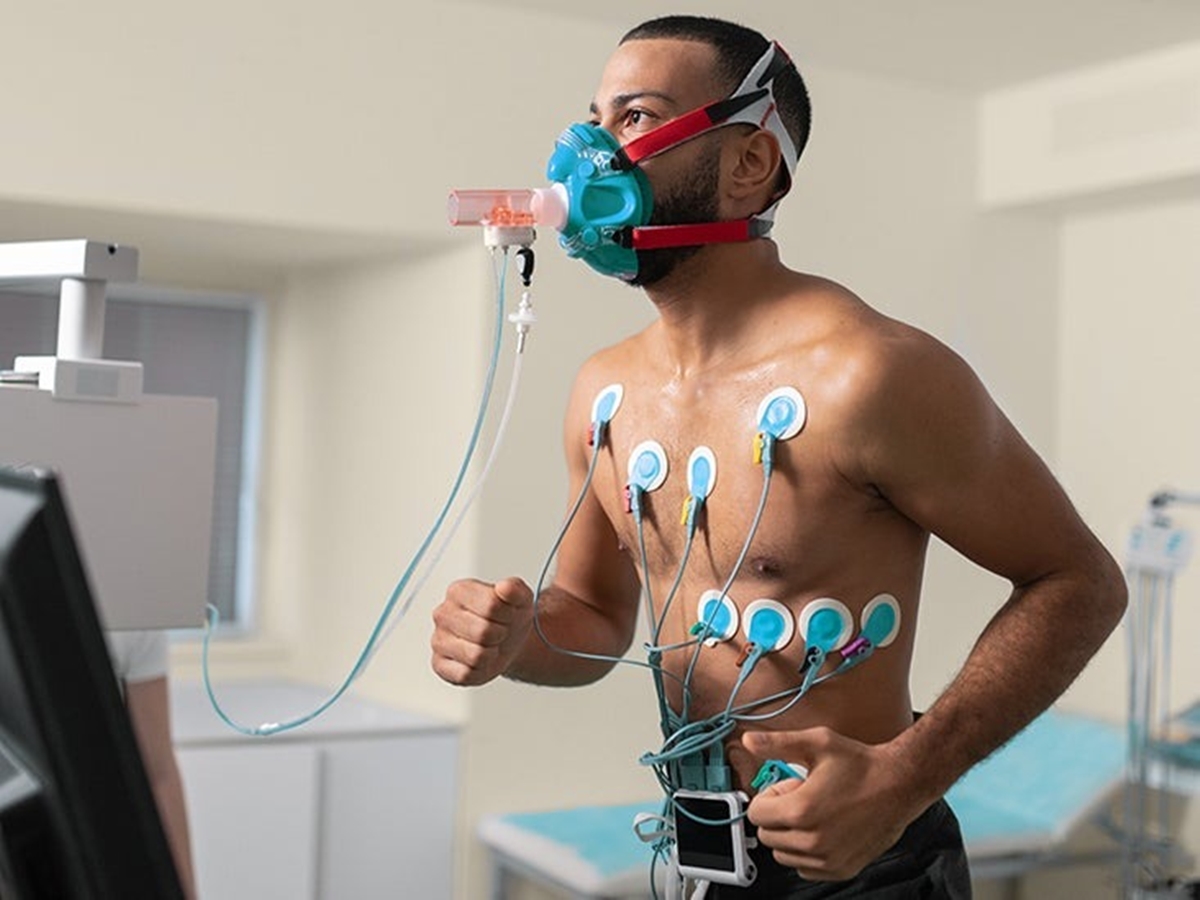Home>Misc>Featured>What Is The Test Most Often Used To Assess Cardiorespiratory Endurance?


Featured
What Is The Test Most Often Used To Assess Cardiorespiratory Endurance?
Modified: January 22, 2024
Discover the featured test most frequently employed to evaluate cardiorespiratory endurance and determine your fitness level.
Introduction
Welcome to the world of fitness and endurance! In the pursuit of a healthy and active lifestyle, it is essential to assess and understand our body’s capacity for cardiorespiratory endurance. Cardiorespiratory endurance, also known as aerobic fitness, refers to the ability of the cardiovascular and respiratory systems to supply oxygen to the working muscles during prolonged physical activity.
Assessing cardiorespiratory endurance is crucial as it provides insights into our overall fitness level and helps us determine the effectiveness of our training programs. By measuring and tracking our cardiorespiratory endurance, we can tailor our workouts, set realistic goals, and make improvements in the areas that need attention.
There are various tests available to assess cardiorespiratory endurance, each with its own set of advantages and limitations. It is important to choose the right test that aligns with our goals, abilities, and the equipment/resources available.
In this article, we will explore the most commonly used test to assess cardiorespiratory endurance. We will delve into its significance, the procedure involved, and the interpretation of the test results. Additionally, we will discuss factors that can affect cardiorespiratory endurance and provide insights into training approaches to enhance this fitness component.
Definition of Cardiorespiratory Endurance
Cardiorespiratory endurance, also referred to as aerobic fitness, is a measure of the body’s ability to sustain prolonged exercise that requires the continuous supply of oxygen to the working muscles. It is a crucial component of overall fitness and plays a significant role in our daily activities and athletic performance.
When we engage in physical activities that increase our heart rate and breathing, our cardiovascular and respiratory systems work together to deliver oxygenated blood to the muscles and remove waste products, such as carbon dioxide. Higher levels of cardiorespiratory endurance indicate greater efficiency in these systems, enabling us to engage in extensive exercise without tiring quickly.
Cardiorespiratory endurance is influenced by various factors, including genetics, age, body composition, and habitual physical activity. Individuals with higher levels of cardiorespiratory endurance generally have a lower risk of cardiovascular diseases, better body composition, improved mental health, and increased overall stamina and energy levels.
To assess cardiorespiratory endurance accurately, we rely on specific tests that challenge the body’s cardiovascular and respiratory systems to measure their capacity and efficiency. These tests provide valuable data that can be used to gauge an individual’s fitness level and design appropriate training programs tailored to their needs.
Improving cardiorespiratory endurance requires consistent training that focuses on activities like running, swimming, cycling, or any other form of continuous aerobic exercise. By engaging in these activities regularly, we can enhance the efficiency of our cardiovascular and respiratory systems, leading to improved endurance and overall fitness.
Importance of Assessing Cardiorespiratory Endurance
Assessing cardiorespiratory endurance is of utmost importance when it comes to understanding and improving our overall fitness level. Here are some key reasons why it is important to evaluate this component of fitness:
- Measuring Fitness Level: Assessing cardiorespiratory endurance provides valuable information about our current fitness level. It helps us understand our body’s ability to perform prolonged physical activities and endurance-based sports. By knowing where we stand, we can set realistic fitness goals and track our progress over time.
- Identifying Health Risks: Cardiorespiratory endurance is closely linked to cardiovascular health. Individuals with low levels of aerobic fitness are more susceptible to various cardiovascular diseases, including heart disease and high blood pressure. Assessing cardiorespiratory endurance can help identify individuals at risk and prompt them to take necessary steps to improve their health.
- Customizing Training Programs: Different individuals have different fitness goals and abilities. By assessing cardiorespiratory endurance, we can identify our strengths and weaknesses in this area. This knowledge allows us to customize our training programs to improve our weaknesses and optimize our performance in endurance-based activities.
- Monitoring Progress: Regularly assessing cardiorespiratory endurance allows us to monitor our progress over time. As we engage in regular exercise and training, we can track improvements in our endurance capacity. This feedback helps us stay motivated and make necessary adjustments to our fitness routine.
- Enhancing Overall Performance: Cardiorespiratory endurance is not only important for cardiovascular health but also for performing well in various physical activities. Whether it’s running a marathon, playing a team sport, or simply keeping up with daily tasks, having good cardiorespiratory endurance enables us to perform better and with less fatigue.
Assessing cardiorespiratory endurance is a valuable tool in understanding our fitness level and overall health. It allows us to tailor our training programs, reduce the risk of cardiovascular diseases, monitor progress, and improve performance in endurance-based activities. By investing time and effort in assessing and improving cardiorespiratory endurance, we can optimize our fitness journey and live a healthier, more active life.
Common Tests Used for Assessing Cardiorespiratory Endurance
There are several tests available to assess cardiorespiratory endurance, each with its own advantages and limitations. These tests are designed to challenge the cardiovascular and respiratory systems and measure their efficiency in delivering oxygen to the working muscles. Here are some of the common tests used:
- VO2 Max Test: The VO2 max test is considered the gold standard for assessing cardiorespiratory endurance. It measures the maximum amount of oxygen that an individual can utilize during intense exercise. This test involves performing strenuous exercise on a treadmill or stationary bike while wearing a mask to analyze the breath. It provides valuable data on an individual’s aerobic capacity and can be used to determine training zones and set fitness goals.
- Submaximal Exercise Tests: Submaximal exercise tests are commonly used to estimate an individual’s cardiorespiratory fitness without pushing them to their maximum effort. These tests often involve activities such as cycling or running on a treadmill at a moderate intensity while monitoring heart rate and other physiological variables. The results are then extrapolated to estimate the individual’s aerobic capacity.
- 1.5-Mile Run Test: The 1.5-mile run test is a simple and practical field test used to assess cardiorespiratory endurance. Participants are required to run 1.5 miles as quickly as possible, and their time is recorded. This test provides a good estimate of aerobic fitness and is commonly used in military and law enforcement settings.
- Step Test: The step test involves stepping up and down on a platform at a specific pace for a set duration. The heart rate is recorded immediately after the completion of the exercise and during the recovery period. This test assesses how quickly an individual’s heart rate returns to its resting state after exercise and provides insights into their cardiovascular fitness.
- Cooper’s 12-Minute Run/Walk Test: In this test, individuals are required to run or briskly walk for 12 minutes while striving to cover as much distance as possible. The total distance covered is an indicator of cardiorespiratory endurance. It is a simple and accessible test that can be performed in various settings.
These are just a few examples of the tests used to assess cardiorespiratory endurance. The choice of test depends on factors such as available resources, participant’s fitness level, and the specific goals of the assessment. It is important to consult with a fitness professional to determine which test is most appropriate for your needs.
Description of the Most Often Used Test
Among the various tests used to assess cardiorespiratory endurance, the VO2 max test stands out as the most often used and widely recognized method. VO2 max, or maximal oxygen consumption, is a measure of the maximum amount of oxygen that an individual can utilize during intense exercise. It provides valuable information about an individual’s aerobic capacity and is used by athletes, trainers, and researchers to assess and monitor cardiorespiratory fitness.
The VO2 max test typically involves performing strenuous exercise, such as running or cycling, while wearing a mask or mouthpiece that collects and analyzes the breath. These specialized devices measure the volume of oxygen consumed and carbon dioxide produced, allowing for the calculation of an individual’s maximal oxygen consumption.
During the test, the intensity of exercise is gradually increased to push the individual to their maximum effort, reaching a point of exhaustion. The testing protocol may vary depending on the purpose and the resources available. Common methods include a graded exercise test on a treadmill or stationary bike, where the workload is systematically increased at set intervals until the individual can no longer continue.
The VO2 max test requires skilled personnel to accurately measure and interpret the data. These professionals monitor heart rate, blood pressure, oxygen consumption, and other physiological variables throughout the test. The collected information provides insights into an individual’s aerobic capacity, energy expenditure, and maximal exercise tolerance.
The results of the VO2 max test are typically reported in milliliters of oxygen consumed per kilogram of body weight per minute (ml/kg/min). This measurement allows for comparisons between individuals of different weights and provides a standardized way to assess cardiorespiratory endurance.
It is important to note that the VO2 max test can be physically demanding and may not be suitable for everyone. Individuals with certain health conditions or limitations should consult with a healthcare professional before undergoing this test. Alternative tests, such as submaximal exercise tests or field tests, can provide valuable insights into cardiorespiratory fitness without the need for maximal effort.
Overall, the VO2 max test is the most widely used and recognized method for assessing cardiorespiratory endurance. It provides valuable information about an individual’s aerobic capacity and is used to set fitness goals, monitor progress, and design effective training programs.
Procedure for the Test
The procedure for the VO2 max test, the most often used test to assess cardiorespiratory endurance, involves several key steps to ensure accurate and meaningful results. While specific protocols may vary, the general procedure is as follows:
- Medical Screening: Before undergoing the test, individuals may be required to complete a medical screening questionnaire. This helps identify any existing health conditions or risk factors that may affect the test or the individual’s safety during the test.
- Warm-up: Prior to the test, a warm-up period is recommended. This typically involves 5-10 minutes of light aerobic exercise, such as jogging or cycling, to elevate the heart rate and prepare the body for the subsequent intense exercise.
- Equipment Setup: The individual is outfitted with the necessary equipment, including a mask or mouthpiece connected to a device that collects and analyzes the breath. This equipment measures oxygen consumption and carbon dioxide production, enabling the calculation of VO2 max.
- Exercise Protocol: The individual begins exercising at a relatively low intensity, such as walking or light jogging on a treadmill or cycling on a stationary bike. The intensity gradually increases at set intervals, with the goal of reaching the individual’s maximum effort and achieving exhaustion.
- Monitoring and Data Collection: Throughout the test, trained professionals monitor various physiological variables. This includes continuous monitoring of heart rate, blood pressure, oxygen consumption, and carbon dioxide production. This data is recorded to analyze the individual’s performance and determine their VO2 max.
- Cool-down: After reaching exhaustion, the individual engages in a cool-down period of light exercise to gradually lower the heart rate and allow for recovery.
- Data Analysis: The collected data is then analyzed to determine the individual’s VO2 max. This measurement is often expressed in milliliters of oxygen consumed per kilogram of body weight per minute (ml/kg/min).
It is important to note that the above procedure is a general guideline, and the specific protocol may vary depending on the testing facility, resources available, and the individual being tested. Trained professionals should oversee the test to ensure safety and accuracy.
Prior to undergoing the VO2 max test, individuals should consult with a healthcare professional, especially if they have any pre-existing health conditions or concerns. It is also essential to follow any instructions or guidelines provided by the testing facility to ensure the best possible results.
By following the appropriate procedure for the test, individuals can obtain reliable and meaningful information about their cardiorespiratory endurance, which can be used to set fitness goals and design an effective training program.
Interpretation of Test Results
Interpreting the results of a cardiorespiratory endurance test, such as the VO2 max test, is crucial in understanding an individual’s aerobic capacity and overall fitness level. Here are some key factors to consider when interpreting the test results:
- VO2 Max Score: The primary measurement obtained from the test is the VO2 max score, which represents the maximum amount of oxygen an individual can consume during exercise. It is usually expressed in milliliters of oxygen per kilogram of body weight per minute (ml/kg/min). Higher scores indicate better cardiorespiratory fitness.
- Comparison to Norms: To put the results into context, it can be helpful to compare the individual’s VO2 max score to established norms for their age, sex, and fitness level. This allows for a better understanding of where they stand in relation to the general population.
- Fitness Level: The VO2 max score provides insights into an individual’s overall fitness level. Higher scores typically indicate a higher level of cardiorespiratory endurance and better fitness. Lower scores may suggest the need for improvement in this area.
- Training Zones: The test results can also help determine appropriate training zones based on the individual’s VO2 max score. These zones can guide the intensity of exercise during training sessions, ensuring that the individual is working within the appropriate range to improve their cardiorespiratory capacity.
- Health Implications: Cardiorespiratory fitness, as indicated by the VO2 max score, has important health implications. Higher levels of cardiorespiratory endurance are associated with a reduced risk of cardiovascular diseases, better overall health, and improved quality of life.
- Progress Tracking: The test results provide a baseline measurement that can be used to track progress over time. By periodically retesting cardiorespiratory endurance, individuals can assess the effectiveness of their training programs and make adjustments as necessary.
It is important to note that interpreting test results should be done in consultation with a qualified professional, such as a sports scientist or exercise physiologist. These experts can provide personalized insights and guidance based on the individual’s unique circumstances.
Overall, interpreting cardiorespiratory endurance test results allows individuals to understand their fitness level, determine appropriate training zones, track progress, and gain insights into their overall health. By analyzing and understanding these results, individuals can make informed decisions to improve their cardiorespiratory endurance and enhance their overall fitness and well-being.
Factors Affecting Cardiorespiratory Endurance
Cardiorespiratory endurance, like any other fitness component, is influenced by various factors. Understanding these factors can help individuals identify areas for improvement and make informed decisions to enhance their cardiorespiratory endurance. Here are some key factors that can affect cardiorespiratory endurance:
- Genetics: Genetic factors play a role in determining an individual’s baseline cardiorespiratory endurance. Some people may have a natural predisposition to higher levels of aerobic fitness, while others may have inherent limitations.
- Age: Cardiovascular and respiratory function naturally decline with age, which can impact cardiorespiratory endurance. However, regular exercise and a healthy lifestyle can help mitigate age-related declines and maintain a good level of endurance.
- Body Composition: Body composition, particularly the ratio of lean muscle mass to body fat, can affect cardiorespiratory endurance. Higher levels of muscle mass tend to be associated with better aerobic fitness, as muscles play a central role in oxygen utilization and energy production.
- Training Status: Regular physical activity and specific training programs have a significant impact on cardiorespiratory endurance. Consistent aerobic exercise improves the efficiency of the cardiovascular and respiratory systems, leading to enhanced endurance capacity.
- Health and Fitness Level: Underlying health conditions, such as cardiovascular diseases, respiratory disorders, or obesity, can negatively affect cardiorespiratory endurance. Additionally, overall fitness level, including muscular strength, flexibility, and body conditioning, can also influence endurance capacity.
- Environmental Factors: Environmental conditions, such as altitude, temperature, and humidity, can have an impact on cardiorespiratory endurance. High-altitude environments, for example, may pose additional challenges due to lower oxygen availability.
- Training Methods: The type and intensity of training methods used to improve cardiorespiratory endurance can also affect the outcomes. The principles of frequency, intensity, duration, and progression should be properly applied to optimize training adaptations.
- Motivation and Mental Factors: Psychological factors, including motivation, mindset, and mental resilience, can influence an individual’s ability to push through physical challenges and maintain consistent training. Mental strength is often crucial in endurance activities.
- Diet and Hydration: Proper nutrition and hydration are essential for optimal cardiorespiratory endurance. Adequate intake of nutrients and fluids supports energy production, muscle function, and overall performance during exercise.
It is important to recognize that these factors interact and may have different degrees of impact on cardiorespiratory endurance for each individual. Moreover, while some factors, such as genetics and age, cannot be easily changed, others, such as training status and lifestyle choices, can be modified to improve endurance capacity.
Understanding the various factors at play can guide individuals in making informed decisions regarding their training, lifestyle habits, and overall approach to improving cardiorespiratory endurance.
Training Approaches to Improve Cardiorespiratory Endurance
Improving cardiorespiratory endurance requires a systematic and targeted approach to training. By incorporating specific exercises and principles into your fitness routine, you can enhance your body’s ability to sustain prolonged physical activities. Here are some effective training approaches to improve cardiorespiratory endurance:
- Aerobic Exercise: Engaging in aerobic exercises, such as running, swimming, cycling, or brisk walking, is essential for improving cardiorespiratory endurance. These activities elevate the heart rate and breathing, challenging the cardiovascular and respiratory systems to adapt and become more efficient over time.
- Interval Training: Interval training involves alternating between high-intensity bursts of exercise and lower-intensity recovery periods. This training method can be particularly effective for improving cardiorespiratory endurance, as it pushes the limits of the cardiovascular system and stimulates physiological adaptations.
- Progressive Overload: To continue improving cardiorespiratory endurance, it is important to gradually increase the intensity, duration, or frequency of your workouts. This concept of progressive overload ensures that your body is consistently challenged and adapts over time.
- Long, Slow Distance (LSD) Training: LSD training involves performing exercise at a steady, moderate intensity for an extended period. This type of training helps build the foundation of endurance by improving aerobic capacity and teaching the body to sustain exercise for longer durations.
- Cross-Training: Incorporating different forms of exercise into your routine, such as swimming, cycling, or using the elliptical machine, can provide variety and prevent overuse injuries. Cross-training also allows for different movement patterns, engaging different muscle groups, and improving overall fitness.
- High-Intensity Interval Training (HIIT): HIIT workouts involve short bursts of intense exercise followed by brief recovery periods. This type of training has been shown to improve cardiorespiratory endurance and can be achieved through activities like sprinting, cycling, or bodyweight exercises.
- Consistency and Frequency: Regularity and consistency in your training routine are key to improving cardiorespiratory endurance. Aim for at least 150 minutes of moderate aerobic activity or 75 minutes of vigorous aerobic activity per week, spread across multiple sessions.
- Gradual Progression: It is important to progress gradually when training for improved endurance. Start with an appropriate level of intensity and duration and gradually increase these factors over time to avoid overexertion and minimize the risk of injury.
- Proper Rest and Recovery: Adequate rest and recovery are essential for improvements in cardiorespiratory endurance. Allow for rest days in your training schedule and prioritize sleep, nutrition, and stress management to support optimal recovery and adaptation.
Remember to consult with a fitness professional before starting any new training program, especially if you have underlying health conditions or concerns. They can provide guidance and tailor a program to your specific needs and goals.
By incorporating these training approaches into your fitness routine, you will gradually improve your cardiorespiratory endurance and enjoy the benefits of increased stamina, improved cardiovascular health, and enhanced overall fitness.
Conclusion
Cardiorespiratory endurance is a vital component of overall fitness and plays a significant role in our daily lives. Assessing and improving cardiorespiratory endurance allows us to enhance our stamina, cardiovascular health, and performance in endurance-based activities.
In this article, we explored the definition of cardiorespiratory endurance and its importance in our fitness journey. We discussed common tests used to assess cardiorespiratory endurance, with a focus on the widely recognized VO2 max test. We also provided a description of the test procedure and highlighted the factors that can affect cardiorespiratory endurance.
Understanding the interpretation of test results is crucial for setting fitness goals and monitoring progress. We discussed how results can be compared to norms, analyzed based on fitness level, and used to determine training zones. It is important to consult with professionals to accurately interpret and apply the results to our training programs.
To improve cardiorespiratory endurance, we explored various training approaches such as aerobic exercise, interval training, and progressive overload. We emphasized the importance of consistency, proper rest, and gradual progression in our training routines.
Improving cardiorespiratory endurance takes time, dedication, and a personalized approach. It is essential to listen to our bodies, seek professional guidance, and make sustainable lifestyle changes to optimize our fitness journey.
By continually assessing and working on our cardiorespiratory endurance, we can enhance our overall fitness, improve our cardiovascular health, and enjoy the benefits of increased stamina and energy in our daily lives and physical pursuits.









